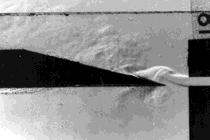Penny or Irish Whistle
This lesson is derived from a project by Jay Brockman.
Penny or Irish whistles work because a vibrating stream of air resonates inside a tube of a given length which produces sound waves at a given pitch. What distinguishes a penny whistle from other types of flutes is its use of a fipple to produce the vibrations. A fipple is a type of mouthpiece where a stream of air is blown through a channel and cut by a blade. This structure allows a thin sheet of air to pass beneath the blade. The fipple makes it easy for the player to set up the vibrations, but gives the player less control over shaping the note. Below is an animated GIF of a fipple producing vibrations:

The pitch or frequency of the note produced by a whistle depends on the tube length. Shorter tubes produce higher frequencies because the frequency is proportional to 1/(tube length).
By drilling holes into the tube, you shorten the tube, which raises the pitch. By strategically placing the holes and covering them with your fingers, you can create an instrument that can play the notes of a scale. A traditional Irish Penny Whistle has 6 holes tuned to play a D major scale.

Materials
1 piece of 1/2" schedule 40 PVC 240 mm long
- Drill bits less than or equal to 1/8"
- A hand drill
- A 3D printer
- Start with a tube cut to 240 mm (9 7/16 inches). Use 1/2" schedule 40 PVC tubing or you will be out of tune.
- Attach 3D printed mouthpiece and use a tuner (such as Track Tuner for an iPhone) to verify that it plays a D. If the note is flat, sand off a bit of the end of the tube and if it is sharp pull the mouthpiece out a little (if it is very sharp you'll need a longer tube).
- Print out a copy of the hole placement drilling guide.
- Remove the mouthpiece and wrap the drilling guide around the tube. Drill small pilot holes (no more than 1/8") at each of the markings.
- Reattach the mouthpiece, cover all the holes and blow. You should still get a D.
- Cover all but the bottom hole with your fingers and blow. You should get a note somewhat flatter than an E as indicated by a tuner. Using the point of a pair of scissors, widen the hole slightly and play. The tuner (and your ears) should indicate the note getting sharper, closer to an E. Keep working the hole with the scissors point until the E is in tune.
- Cover all but the bottom two holes with your fingers and repeat the process with the second hole from the bottom until you get an F# in tune.
- Repeat the process for the remaining holes, using the fingering chart as shown above.
